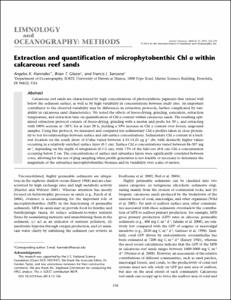| dc.contributor.author | Hannides, Angelos K. | |
| dc.contributor.author | Glazer, Brian T. | |
| dc.contributor.author | Sansone, Francis J. | |
| dc.date.accessioned | 2021-07-26T19:55:12Z | |
| dc.date.available | 2021-07-26T19:55:12Z | |
| dc.date.issued | 2014 | |
| dc.identifier.citation | Hannides, Angelos K., Glazer, Brian T. and Sansone, Francis J., (2014) Extraction and quantification of microphytobenthic Chl a within calcareous reef sands, Limnology and Oceanography : Methods, 12,pp.126-138. DOI:10.4319/lom.2014.12.126. | en_US |
| dc.identifier.uri | https://repository.oceanbestpractices.org/handle/11329/1627 | |
| dc.identifier.uri | http://dx.doi.org/10.25607/OBP-1559 | |
| dc.description.abstract | Calcareous reef sands are characterized by high concentrations of photosynthetic pigments that extend well
below the sediment surface, as well as by high variability in concentrations between study sites. An important
contributor to the observed variability may be differences in extraction protocols, further complicated by variability
in calcareous sand characteristics. We tested the effects of freeze-drying, grinding, sonication, extraction
temperature, and extraction time on quantification of Chl a content within calcareous sands. The resulting optimized
extraction protocol consists of freeze-drying, grinding with a mortar and pestle for 30 s, and extracting
with 100% acetone at –20°C for at least 20 h, yielding a 39% increase in Chl a content over frozen, unground
samples. Using this protocol, we measured and compared ten sedimentary Chl a profiles taken in close proximity
to test for relationships between surface and sub-surface concentrations. Sedimentary Chl a content at a backreef
location on the south shore of O‘ahu varied between 4.33-14.25 μg g–1 dw, with distinctly higher values
occurring in a relatively enriched surface layer (0-1 cm). Surface Chl a concentrations varied between 86-307 mg
m–2, depending on the depth of integration (0.5-2 cm), with 73% of the full-core (0-8 cm) Chl a concentration
occurring below 2 cm. The concentrations of surface and subsurface layers were significantly correlated between
cores, allowing for the use of plug sampling when profile generation is not feasible or necessary to determine the
magnitude of the subsurface microphytobenthic biomass and its variability over scales of meters. | en_US |
| dc.language.iso | en | en_US |
| dc.rights | Attribution 4.0 | * |
| dc.rights.uri | http://creativecommons.org/licenses/by/4.0/ | * |
| dc.title | Extraction and quantification of microphytobenthic Chl a within calcareous reef sands. | en_US |
| dc.type | Journal Contribution | en_US |
| dc.description.refereed | Refereed | en_US |
| dc.format.pagerange | pp.126-138 | en_US |
| dc.identifier.doi | 10.4319/lom.2014.12.126 | |
| dc.subject.parameterDiscipline | Other organic chemical measurements | en_US |
| dc.subject.dmProcesses | Data acquisition | en_US |
| dc.bibliographicCitation.title | Limnology and Oceanography: Methods | en_US |
| dc.bibliographicCitation.volume | 12 | en_US |
| dc.description.sdg | 14.a | en_US |
| dc.description.eov | N/A | en_US |
| dc.description.adoption | Validated (tested by third parties) | en_US |
| dc.description.supportingotherVariables | Chlorophyll a | en_US |
| dc.description.methodologyType | Method | en_US |
| dc.description.methodologyType | Reports with methodological relevance | en_US |
| obps.contact.contactname | Angelos Hannides | |
| obps.contact.contactemail | hannides@hawaii.edu | |
| obps.resourceurl.publisher | https://aslopubs.onlinelibrary.wiley.com/doi/pdf/10.4319/lom.2014.12.126 | |
 Repository of community practices in Ocean Research, Applications and Data/Information Management
Repository of community practices in Ocean Research, Applications and Data/Information Management

